
PUMPA - SMART LEARNING
எங்கள் ஆசிரியர்களுடன் 1-ஆன்-1 ஆலோசனை நேரத்தைப் பெறுங்கள். டாப்பர் ஆவதற்கு நாங்கள் பயிற்சி அளிப்போம்
Book Free DemoImagine you see an animal with a long neck and long slender limbs. You can say that the animal is a Giraffe. We have the natural ability to identify an organism by its external feature.
Morphology is the study of the form or structure of an organism.
The external characteristic feature of the rabbit is discussed in this object.
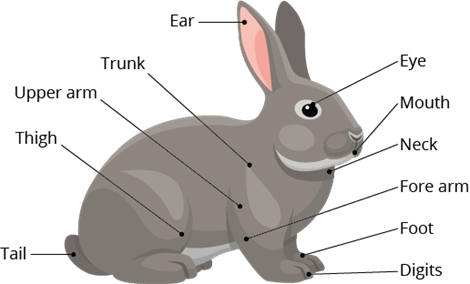
External features of rabbit
Shape:
The body of the rabbit is elongated and cylindrical in shape.
Size and weight:
The male and female rabbits are approximately equal in size. They reach about a maximum length of 45 cm. and the average adult rabbit weighs around 2.25 kg.
Colouration:
The rabbit's colour varies from white to black and white. Fur covers the body, which helps to keep it warm.
Body division:
The rabbit's body has a typical mammalian form, with a head, neck, trunk and tail. The trunk is further divided into the thorax and abdomen.
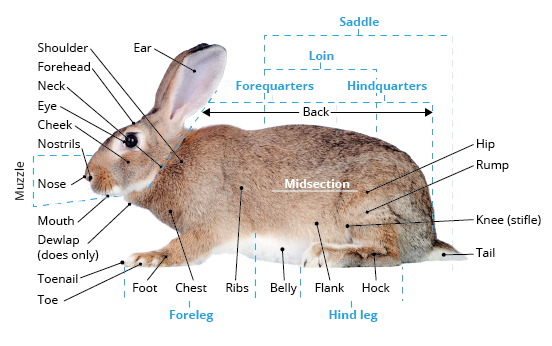
Rabbit parts labelled
Head:
The head is ovoid and flattened with a truncated snout.The following structures can be found on the head:
- Mouth
- External nares
- Vibrissae
- Eyes
- External ears or pinna
Mouth:
The rabbit's mouth is a transverse slit-like opening bounded by the upper and lower lips, which are soft and flexible.
External nares and Vibrissae:
The nostrils are two oblique slits like openings just above the mouth. The rhinarium, which surrounds the nostrils with bare moist skin, leads into the nasal or olfactory chambers.
Important!
Note: In many mammals, the rhinarium is the hairless skin that surrounds the nostrils.
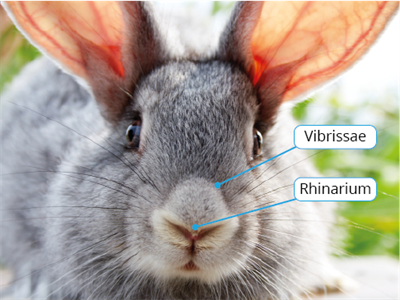
Rhinarium and Vibrissae of a rabbit
Thick tactile hairs called vibrissae (whiskers) protrude from each side of the upper lip. The hairs are stiff, lengthy, and sensitive because they have nerve endings surrounding their bases.
Eyes:
At the sides of the head are two eyes, each with movable upper and lower eyelids and very fine, short eyelashes. The nictitating membrane, a little white third eyelid, is also present in the inner anterior comer of the eye. The nictitating membrane is also stretchable and can be stretched over the cornea to clean it.

Structure and vision of rabbit
External ears or pinna:
At the top of the head are a pair of large, moveable trumpet-shaped external ears or pinnae. The lengthy pinnae can move in all directions to receive sound waves. When the rabbit is on alert and laid back on frightened and running, both pinnae remain upright.
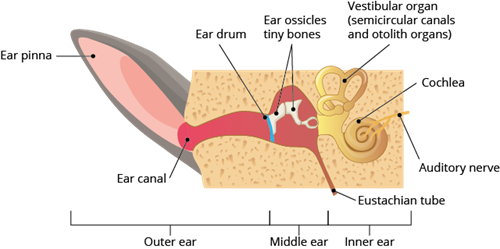
Anatomy and physiology of rabbits ear
Neck:
The neck is a bodily extension that connects the head to the trunk. It helps to move the head in every direction. The rabbit's neck is short and flexible. Its digging and fast-running behaviours benefit from its small neck.
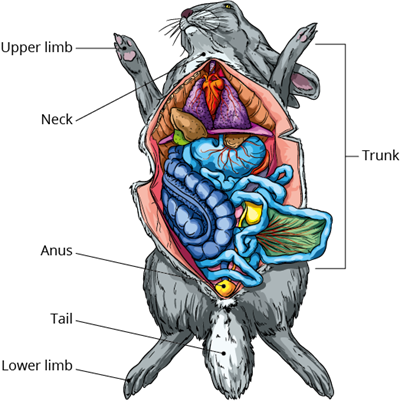
Parts of rabbit
Trunk:
The large, cylindrical trunk follows the neck. An anterior thorax and a posterior large, soft-bellied abdomen make up the trunk.
The thorax, or chest, is a bone cage with ribs on the sides and a sternum on the ventral side. The abdomen is without ribs and sternum. Tender bodily components such as the heart and lungs are protected in the thorax cavity.
Teats:
On the ventral surface between the thorax and the abdomen, females have four or five teats or nipples.
Limbs:
The trunk bears two pairs of pentadactyl limbs. Both pairs of limbs assist in locomotion and support the body's weight. The forelimbs are significantly shorter than the hindlimbs. All of the digits have claws on them.
Anus:
The anus is located at the base of the tail at the posterior end of the abdomen. A vulva-like slit can be found on the ventral side of females. The penis is located on the ventral side of the anus in males. Scrotal sacs contain a pair of testes in the male.
The tail is short and bushy, which is located at the hind end of the trunk. It is used to warn other rabbits when they are in danger approaches.